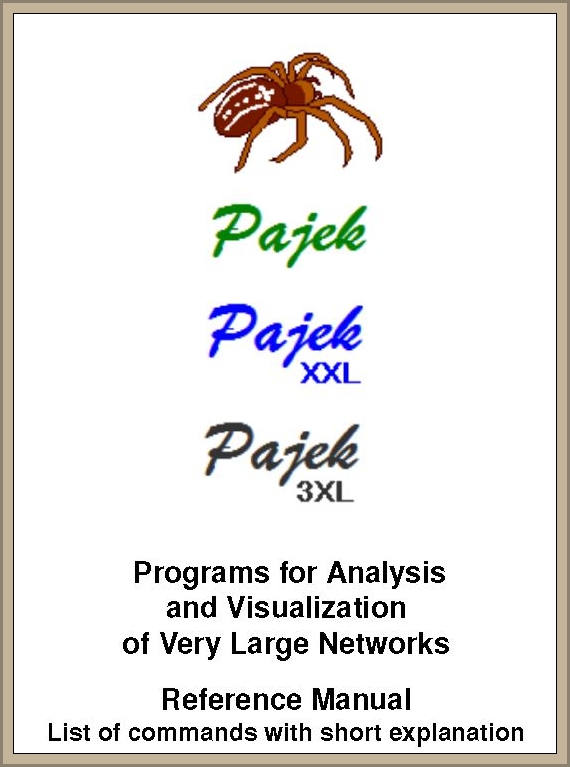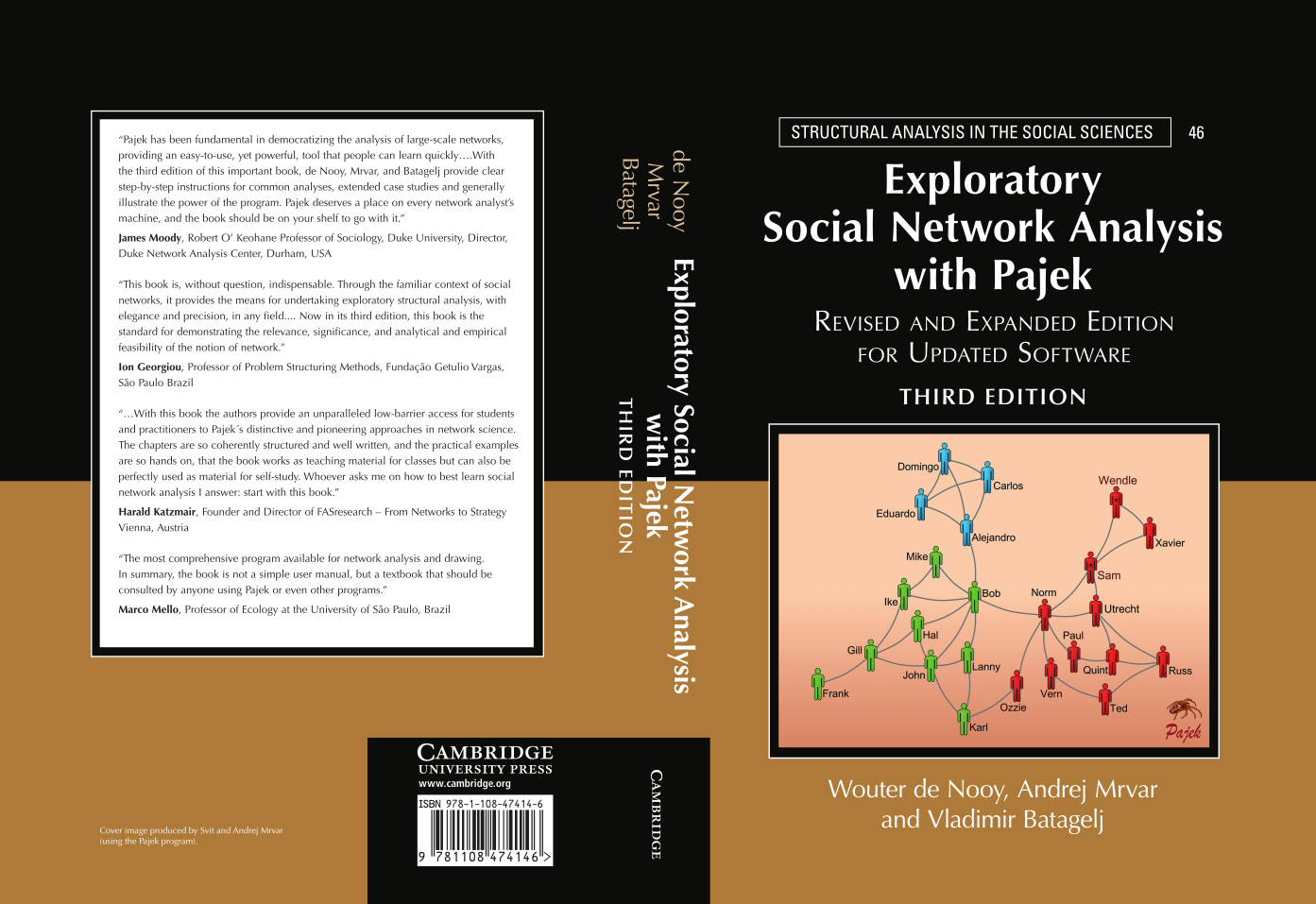 |
de Nooy, W., Mrvar, A., and Batagelj, V. (2018):
Exploratory Social Network Analysis with Pajek:
Revised and Expanded Edition for Updated Software. Third Edition.
New York: Cambridge University Press. |
| Books | Pajek Book Edition 3 | Manual |
|
|
|
 |
|
Preface to the Third Edition
Two major developments in program Pajek required a new edition of this book: a fundamental redesign of the menu structure and the capability to analyze much larger networks, containing billions of vertices. A proliferation of methods for analyzing a single network necessitated a reorganization of Pajek's menu structure, in particular the former Net menu, now called the Network menu. The new Network menu contains submenus for commands that apply to a particular type of network: a two-mode network, multiple relations network, acyclic network, temporal network, and signed network. It is much easier now to find analyses for special networks. Because the Network menu is used most intensively, we had to adjust most of the commands in the Application Sections of this book.
Pajek's capability to analyze much larger networks is the second major development. Due to changes in the Windows operating system, Pajek can now handle networks with nearly one billion vertices. For even larger networks, PajekXXL and Pajek3XL have been developed, which can handle up to two and ten billion vertices respectively. PajekXXL and Pajek3XL have the same user interface as Pajek; if you can work with Pajek, you can also work with PajekXXL and Pajek3XL. What you need to know is that the latter two programs offer a very limited set of analyses to describe and partition huge networks. Subnetworks extracted from a huge network can be sent directly to (regular) Pajek for further analysis. Appendix A1.5 explains all of this.
Questions on how to install and use Pajek on Mac OS X have been asked repeatedly. This new edition brings an additional appendix (Appendix 3) containing detailed instructions on installing Pajek under Mac OS X. We hope that Mac users will find out that installing and running Pajek on Mac OS X is not a difficult technical problem: Installation takes only few additional minutes compared to installation under native Windows. When Pajek is installed, running Pajek under Mac OS X is the same as running it under Windows.
Finally, we took the opportunity to include some analyses requested by Pajek users. Chapter 1 now includes Pivot MDS and VOS Mapping for network layout as well as the correlation between layout coordinates and network geodesics as a measure of layout performance. Chapter 2 introduces partitions on vertex labels using regular expressions and marking partition clusters with Unicode symbols in the Draw screen. It also discusses interactive Fisheye magnification and the Adjusted Rand Index. Relaxed balance is explained in Chapter 4, community detection (Louvain method and VOS Clustering) and the E-I Index appear in Chapter 5. Chapter 6 includes (degree) assortativity and the assortativity coefficient. A collection of main path methods (including key-route searches) and preprint transformation are explained and applied in Chapter 11. Appendices A1 and A2 have been updated, now containing goodies such as dragging & dropping data to a Pajek window, sending Pajek objects to Excel, defining colors and transparency of vertices and lines, using Unicode symbols and additional vertex shapes (e.g., man, woman, and house), tooltips for vertex labels, drawing curved lines, and so on. We hope that you will continue enjoying social network analysis with Pajek.
|
Additional Sources by Chapters
Chapter 1
Visualizing communities using 2D Pivot MDS
Visualizing communities using 3D Pivot MDS
Chapter 2
Some visualizations with symbols
Visualizing by shrinking
Chapter 4
Papers, visualizations, animations, and instructions on signed networks
Chapter 5
Additional Pajek shapes: house, man, and woman
Detecting communities in Pajek
Comparing Louvain method and VOS Clustering
Example of visualizing communities in collaboration network (provided by James Moody)
Chapter 8
Macros and session (LOG) files
Chapter 11
Genealogies in Pajek: Papers, presentations, fragments, macros...
Main path analysis (Wikipedia)
How to use Pajek to find main path (Video)
Chapter 12
Generalized blockmodeling with Pajek
Appendix 1
Running Pajek on MAC
Running Pajek on Linux
Running Pajek on Linux64
txt2Pajek (by Juergen Pfeffer): Create Pajek files from text files (version 3)
Using Unicode in Pajek
PajekXXL and Pajek3XL, Example1, Example2
Appendix 2
PajekToSvgAnim (by Darko Brvar): Zip (version 1.10.9.6, August 19, 2016), TestData, Manual
Exporting Visualizations to VOSviewer
Example of using Tooltips in SVG export
Bezier curves as default shapes of lines in Pajek
Animations of the Correlates of War data
Drawing edges and arcs transparently in Pajek
Drawing vertices transparently in Pajek
Solving the problem of unwanted visibility of lines behind transparent vertices in Pajek
Some visualizations with symbols
house, man, and woman as additional shapes
|
|



